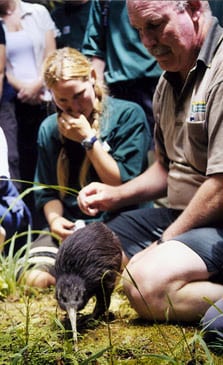
Sunny the kiwi being released at Egmont National Park
Why translocation proposals are needed
A translocation proposal details how you will plan, consult, carry out transfers, monitor, and report on your translocation.
Translocation is a complex process that can have important, long-lasting effects - not just on the animal or plant being moved, but often on its whole environment
It is important that you consult with tangata whenua and other stakeholders to ensure ongoing support and maintain strong working relationships. This helps with future translocations.
Translocations can take a lot of time, effort and money. It's important that every step of the translocation is thought through carefully before it goes ahead.
Your DOC contact person will discuss the translocation proposal and any permits you may require.
How to propose a translocation.
When you need a translocation proposal
Translocation proposals are required if you plan to move native animals (and sometimes certain plants):
- from the wild to captivity
- from captivity to the wild
- between wild locations.
Proposals are not required for:
- captive to captive transfers
- injured or sick wildlife being treated under permits to temporarily hold injured wildlife
- aquatic life (there is a separate process for these)
- marine plants and animals (except for birds)
- some situations where wildlife is relocated from sites affected by development under RMA consents
- exotic animals
- indigenous animal species that are game (Schedule 1 of the Wildlife Act) or that are protected (Schedule 5 of the Wildlife Act)
- exotic plant species
- revegetation/restoration planting projects that have an approved restoration plan
When do you need a permit
Even if you don't need an approved translocation proposal for your translocation, you will probably still need a permit from DOC.
Permits are required for:
- collecting or releasing animals or plants on land managed by DOC
- translocation of wildlife (including marine species) covered by the Wildlife Act
- translocation of aquatic life and marine mammals.
Plan for success
When planning and carrying out translocations, you should aim to do the following.
Have good planning and decision making
- Have a good project team
- Consult and seek appropriate advice
- Be realistic about how long the planning and preparation takes
- Involve tangata whenua and stakeholders
- Have sufficient funding or a plan to obtain it
Show that your proposal is ecologically sound
- Plan the translocation well to have a high chance of success
- Consider the foreseeable implications of the translocation
- Consider disease risks and how to manage them
- Include features in the design that worked in other translocations
- Include post-release management to improve the chance or success
Learn from what you do
- Monitor the translocation and write it all down
- Analyse the results (What lessons did you learn? What needs to change?) and prepare reports
- Make the information available to others so they can make improvements
- Sharing information will help to boost the success of future translocations